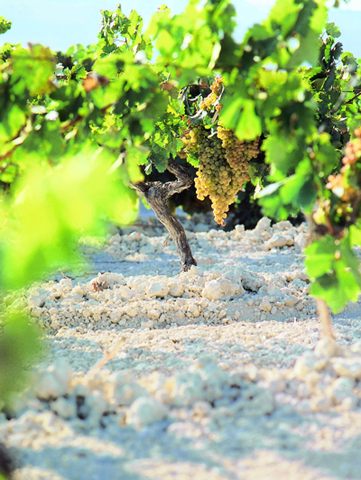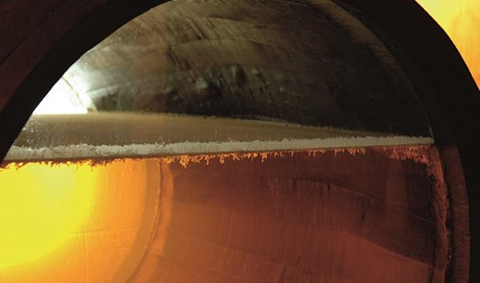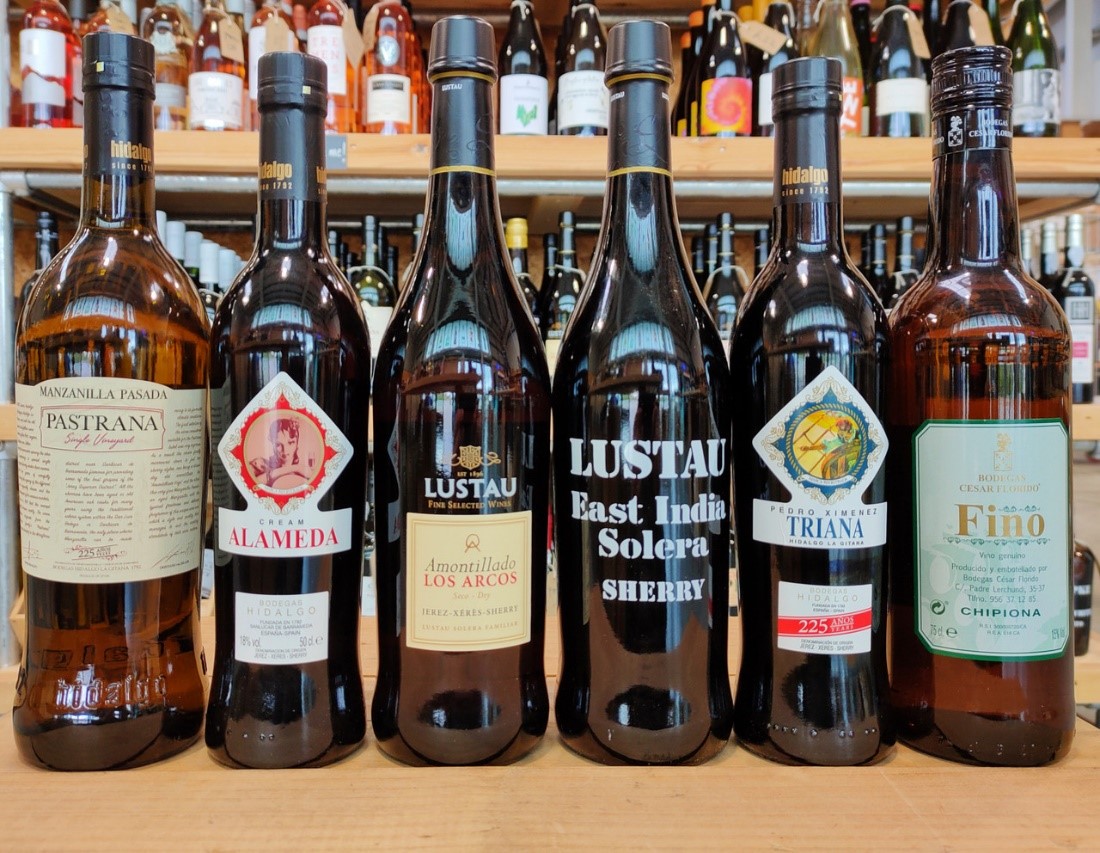Sherry – A brief Introduction!
Posted by EWWines on 4th Nov 2022
Sherry is a fortified wine made from white grapes which can only be produced in Jerez-Xérès-Sherry D.O, in Andalucia, South West Spain. Sherry is the oldest D.O of Spain, Jerez-Xérès-Sherry D.O, founded in 1933! Our next event at EWWines is a Sherry evening where we are hosting Lustau on the 4th November, more information here.
From a business perspective, the region and sherry wines unfortunately experienced a large decline in sales over the last 30 years, which combined with huge over supply has caused large challenges to the region and its wines. In 2021 changes to the DO have permitted other historic varieties to be used; this is expected to revitalise Sherry wines on the international markets. Sherry wines are benefitting from the international trend in premiumisation of consumption and upturned sales during covid lockdowns has created a renewed interest with a new generation of sherry lovers which can see the versatility and value of the wines.
The three key grape varieties for Sherry production are Palomino, Moscatel and Pedro Ximinez. Nowadays Palomino makes up 98% of all plantings. Palomino is a high yielding variety which produces wines of low acidity and neutral fruit – this allows the unique winemaking biological and oxidative ageing processes to shine which creates the unique styles and flavours of sherry wines – which we will discuss later. Moscatel and Pedro Ximénez are used to produce sweet sherries often with the aid of the powerful sunshine to dry the grapes after harvest which concentrates the sugars and flavours as water is evaporated. The drying process is known locally as Soleo and is shown below.

(image from Sherry Notes)
The climate of the region is warm Mediterranean with hot and dry summers, often over 40 degrees! To the West of the region lies the Atlantic Ocean, which has a strong cooling influence. This proximity to the ocean creates plentiful winter rainfall. The cooling ocean creates a strong westerly humid wind called the Poniente which reduces the summertime temperatures making viticulture possible and brings humidity and rainfall to the region. The humidity and warm climate are essential for the development of Flor the yeast layer essential for the biological aged wines – discussed in more detail when discussing the winemaking processes.

(Image from Sherry Wine)
The key soil in the region is a white in colour Albariza as above image. Its high chalk content provides good drainage at the surface but crucially for the winter rainfall excellent water storage capacity at depth. This allows for enough water to be stored to sustain the vines during the warm dry summers. It is common practise to find hand dug troughs on slopes to promote maximum water retention from these winter rains.

(Map from Sherry Wine)
As the map above shows, the epi centre is the city of Jerez de la Frontera but the other two points of the sherry triangle are the coastal towns of El Puerto de Santa Maria and Sanlúcar de Barrameda. Jerez-Xérès-Sherry D.O must be matured in one of these three places. There are 6 communes outside of these towns within the region that are permitted to produce the grapes for Jerez-Xérès-Sherry D.O.
To celebrate the sherry triangle, Bodegas Lustau have limited releases of a trio of En Rama sherries, three pure expressions one from each town of the Sherry Triangle. En Rama is the newest category of sherry pioneered in just 1999. En Rama translated is from the branch which refers to the sherry coming straight from the vine unfiltered and is sherry’s raw and exciting category. Taste around the sherry triangle with Bodegas Lustau’s limited releases.
Due to the hot climate of the region, grapes must reach the press quickly to avoid unwanted oxidation. In the winery, the Palomino grape variety almost exclusively produces the dry wines of Jerez. Fermentation typically takes place at warm temperatures in stainless steel with the aim of producing a dry neutral still wine in the region of 11 – 12%abv.
Following the fermentation, in the first autumn after the harvest, the wines are first classified into two types destined for biological or oxidative ageing. The lightest wines with the most finesse are selected for biological ageing and the darker and richer wines are selected for oxidative ageing. At this stage it is important to note that the famous Flor layer starting to develop on the surface of each wine. Flor is the thin veil of yeasts which form on the top of biologically aged sherry wines. Flor grows specifically in the microclimate of the Sherry region where the combination of temperature and humidity promote growth. Bodegas styles and quantities required impact the choices too at the first classification but as a general rule of thumb the coastal vineyards which are cooler due the Atlantic influence produce the lighter wines destined to become Manzanilla and Fino’s. On the other hand, the wines from the warmer inland vineyards and fermented at a higher temperature tend to be suitable for oxidative ageing destined to become Oloroso sherries.
Following the first classification, all the wines are fortified with a neutral spirit and before they enter the solera are stored in a stage called sobretabla for a short few months' period.
The wines classified for biological ageing are fortified to the lower level of 15 to 15.% abv. This is the ideal strength for the development of Flor. Flor yeasts feed off the alcohol and other nutrients in the wines and oxygen from the atmosphere to produce carbon dioxide and acetaldehyde. The Flor layer protects the wine from oxygen. The acetaldehyde produced creates the unique aromas of bruised green apple skin, fresh bread and almonds found in biologically aged sherry wines.

(image from Bodegas Lustau)
Next is a second classification. Here the winemaker is checking that Flor has formed and the wine has the flor style and character suitable for its destined solera described previously. If not, the wine will be refortified for oxidative ageing or rejected altogether.
Oxidative ageing wines are fortified to 17% because at this strength the Flor dies. The period of sobretabla is not as critical for these wines as it is not critical to see whether Flor flavours develop. Oxidative styles of sherry (Oloroso sherries) are darker, nuttier and have no acetaldehyde bruised apple skin character.
Sherry is famous for its solera system of maturation. This is the versatile system used to sustain both biological and oxidative ageing. The solera system is made up of a series of groups of butts (600l neutral barrels) referred to as levels (criaderas) which hold wine of different ages. Over time the solera system is designed to blend younger and older wines together in a fractional methodical system. Therefore, the solera system refers to the maturation system as a whole. Not to be confused with the solera which refers to the level which holds the wine with the average oldest age!

(image from Bodegas Lustau)
The typical number of criaderas varies from 3 to 14 depending on the solera system and whether oxidative or biological wine is being matured. Oxidative styles are commonly matured for 30 years but biologically aged styles typically are released at 4 to 7 years old. After that age, there are little nutrients left to sustain the Flor.
Although this sounds like a complex system, the advantage is that the wine taken from the solera for bottling is always the same. This system achieves incredible consistency. However, the consistency can’t be maintained if poor quality wines enter the solera therefore, the first and second classifications are as crucial as the solera system, especially for wines which will be biologically aged.
A great way to round up is to highlight our Ultimate sherry mixed case:

In 6 bottles you will be able to explore or revisit all the sherry styles from the delicate and driest to the lusciously sweet. The best way to learn is by thinking about wine with a glass after all, what a great excuse. Cheers to sherry!!

